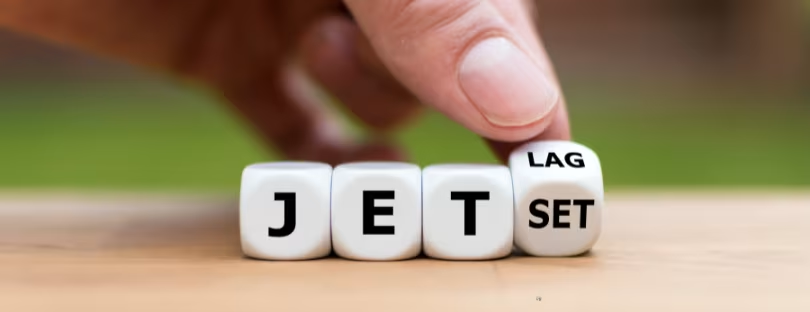
The New Face of Jet Lag: How AI-Powered Wearables are Helping Travelers Beat Time Zones
We’ve all been there. You land in a new country, eager to explore or get that important meeting over with, and then—bam—jet lag hits like a brick wall. Your brain thinks it’s 2 a.m., but your schedule demands energy and focus. It’s the traveler’s curse. AI wearables for jet lag
But things are changing. And no, not in a sci-fi, teleportation kind of way (unfortunately). Instead, the fight against jet lag is going techy—with AI-powered wearables stepping in to do more than just count your steps or buzz you when you’ve been sitting too long.
Let’s talk about the new secret weapon in every frequent flyer’s arsenal.
So, What’s the Deal with Jet Lag Anyway?
Jet lag isn’t just being “tired after a flight.” It’s your internal clock (circadian rhythm) getting thrown off by hopping across time zones. You feel foggy, moody, and hungry at weird hours—or not hungry at all—and sleeping becomes a whole challenge in itself. Your body needs time to adjust to the new rhythm, and that’s usually a slow, uncomfortable process.
For years, the advice was pretty basic: get sunlight, avoid caffeine, try melatonin, maybe pull an all-nighter (bad idea, by the way). But now, there’s a smarter approach.
Enter AI-Powered Wearables
Wearables have been around for a while. Fitness trackers, smartwatches, and and rings that monitor your sleep. But the latest generation is doing more than recording data—they’re using AI to analyze and predict what your body needs. This means personalized recommendations to help your body adapt to a new time zone before jet lag even kicks in.
These wearables collect real-time data—things like heart rate variability, skin temperature, sleep patterns, light exposure—and use AI algorithms to understand how your body responds to travel. Then, they create a step-by-step plan tailored to you. It’s like having a personal jet lag coach on your wrist.
How Does It Actually Work?
Let’s break it down.
- Before You Travel
Some wearables, like the Oura Ring or WHOOP, begin the process days before your flight. They start analyzing your circadian patterns and help you gradually shift your sleep and wake times to match your destination. It’s subtle—you might get nudges to go to bed 15 minutes earlier or wake up slightly later, depending on where you’re heading. - During the Flight
These devices know you’re in transit and will guide you through what to do. Maybe it’s suggesting when to sleep on the plane, when to avoid meals, or when to drink water. Some will even recommend light exposure or melatonin—timed precisely to help your brain start syncing with your new schedule. - After Landing
Here’s where things get even cooler. The wearable continues monitoring your data and adjusts your plan based on how you’re adapting. If you slept poorly the first night or your heart rate is showing signs of fatigue, it might suggest more sunlight or a strategic nap (yes, there is such a thing). It’s flexible and responds to you, not just a generic schedule.
It’s Not Just About Sleep
What’s fascinating is how holistic this has become. AI wearables are connecting the dots between your sleep, hydration, movement, stress, and even mental performance.
You might get a prompt to meditate for five minutes in the morning or do a light stretch before bed. If your device notices your resting heart rate is higher than normal post-flight (a sign your body’s stressed), it might suggest taking it easy that day—even if your itinerary says otherwise.
It’s about optimizing your whole body, not just knocking you out at night.
Real Travelers, Real Results
Let’s be honest: this tech isn’t just for Olympic athletes or CEOs flying first class. More everyday travelers are picking up on it. I’ve spoken to digital nomads who swear by their wearables, saying it’s made long-haul flights feel almost… manageable.
One traveler I met in Lisbon used his WHOOP band to shift his schedule while flying from L.A. to Europe. He followed the app’s suggestions—blue light exposure before the flight, skipped the wine (sadly), and forced a nap mid-flight. He said he felt “surprisingly human” the next day instead of like a zombie, which he considered a big win.
So, Are Wearables the Cure?
Let’s not oversell it—jet lag hasn’t been erased from existence. But this tech is absolutely changing the game. Instead of reacting after you land, you’re working with your body before and during the journey. And when your wearable knows your habits, rhythms, and stress levels? That’s a level of precision that Google-searching “how to beat jet lag” just can’t match.
And honestly, it feels like just the beginning. As this tech improves, we’ll likely see wearables syncing with flight itineraries automatically, adjusting recommendations in real-time, maybe even offering smart lighting or temperature tweaks in hotel rooms.
Should You Try It?
If you travel frequently—whether for business, adventure, or just visiting family—an AI-powered wearable might be worth the investment. Not just for jet lag, but for overall performance and wellbeing.
Here’s a quick list of popular options worth checking out:
- Oura Ring: Compact, stylish, and known for detailed sleep tracking. Great for subtle guidance without constant buzzing.
- WHOOP: More performance-focused, ideal for travelers who also train or care about recovery.
- Apple Watch with apps like Timeshifter: If you’re already using a smartwatch, there are apps that use AI to do similar jet lag planning.
- Garmin and Fitbit: Also getting smarter with AI sleep and stress tracking.
Final Thoughts about AI wearables for jet lag
Jet lag hasn’t vanished, but it’s no longer something we just suffer through. With the help of AI and some clever wearables, we’re moving toward a world where travel doesn’t have to mean dragging your body through three time zones of confusion.
So the next time you’re booking that red-eye flight, consider letting a tiny piece of tech help you land like a local. Your body—and your brain—will thank you.











